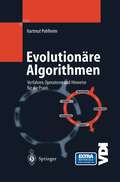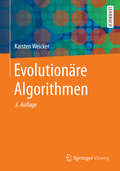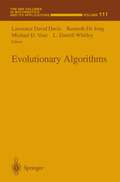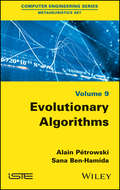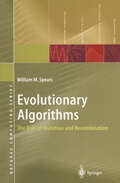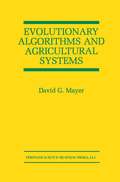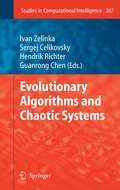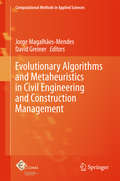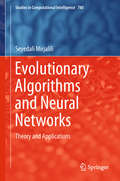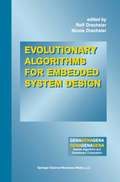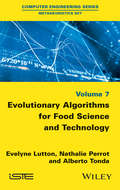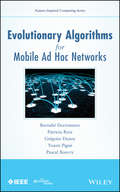- Table View
- List View
Evolutionäre Algorithmen: Verfahren, Operatoren und Hinweise für die Praxis (VDI-Buch)
by Hartmut PohlheimEvolutionäre Algorithmen als Optimierungsverfahren bieten vielfältige Anwendungsmöglichkeiten für ingenieurtechnische Lösungen industrieller Aufgaben. Dieses Buch dient in seiner Aufbereitung als praxisnahes Nachschlagewerk. In anwendungsorientierter Art und Weise werden, von einer einfachen Struktur Evolutionärer Algorithmen ausgehend, grundlegende Bestandteile, Verfahren, Operatoren und Erweiterungen beschrieben und in ihren Anwendungsmöglich- keiten analysiert. Durch die ausführliche Darstellung mehrerer ausgewählter Praxisbeispiele wird ein Einblick in die Anwendung Evolutionärer Algorithmen gegeben. Für den Einsatz in der Praxis ist dies von unschätzbarem Wert. Die dem Buch beiliegende Toolbox für Matlab bietet einen guten Einstieg in die Arbeit mit Evolutionären Algorithmen und kann sofort für die Lösung eigener Praxisprobleme genutzt werden. Der Benutzer erhält neben dem notwendigen Grundwissen ein wertvolles Arbeitsmittel an die Hand.
Evolutionäre Algorithmen
by Karsten WeickerFür die Lösung von Optimierungsproblemen mit evolutionären Algorithmen stattet dieses Buch seine Leser sowohl mit den gängigen Standardalgorithmen als auch mit den Arbeitsprinzipien, Vorgehensweisen und speziellen Techniken aus, mit denen evolutionäre Algorithmen für spezielle Probleme angepasst werden. Dabei zeichnen das Buch vor allem die hohe Anzahl an Beispielen, die anschauliche Darstellung der Grundlagen sowie vier ausführliche Fallstudien aus. Für die Anwendung evolutionärer Algorithmen in Industrie, Wirtschaft und Forschung sind die vorgestellten Ansätze zur Berücksichtigung von Randbedingungen, mehrerer sich widersprechender Zielfunktionen und verrauschte oder zeitabhängige Aspekte von großer Bedeutung. Evolutionäre Algorithmen sind ein vergleichsweise junges Optimierungsverfahren, welches das Wechselspiel zwischen Variation und Selektion der natürlichen Evolution imitiert.
Evolutionäre Algorithmen (XLeitfäden der Informatik)
by Karsten WeickerEvolutionäre Algorithmen sind relativ neue Methoden zur Lösung von Optimierungsproblemen in Industrie, Wirtschaft und Forschung. Inspiriert durch die biologische Evolution imitieren sie das Wechselspiel zwischen Variation von Individuen und Selektion. In diesem Lehrbuch wird neben der Darstellung der Standardalgorithmen vor allem das gängige Verständnis für die Arbeitsweise und die zu Grunde liegenden Prinzipien vermittelt. Darüber hinaus werden spezielle Anforderungen aus der Praxis, wie z. B. die Beachtung von Randbedingungen, Mehrzieloptimierung und verrauschte oder zeitabhängige Probleme, diskutiert. In der nun vorliegenden zweiten Auflage wurde insbesondere die praktische Anwendung anhand von Fallbeispielen aus verschiedenen Themenbereichen stärker berücksichtigt.
Evolutionary Algorithms (The IMA Volumes in Mathematics and its Applications #111)
by Lawrence D. Davis Kenneth De Jong Michael D. Vose L. Darrell WhitleyThis IMA Volume in Mathematics and its Applications EVOLUTIONARY ALGORITHMS is based on the proceedings of a workshop that was an integral part of the 1996-97 IMA program on "MATHEMATICS IN HIGH-PERFORMANCE COMPUTING." I thank Lawrence David Davis (Tica Associates), Kenneth De Jong (Computer Science, George Mason University), Michael D. Vose (Computer Science, The University of Tennessee), and L. Darrell Whitley (Computer Science, Colorado State University) for their excellent work in organizing the workshop and for editing the proceedings. Further appreciation is ex tended to Donald G. Truhlar (Chemistry and Supercomputing Institute, University of Minnesota) who was also one of the workshop organizers. In addition, I also take this opportunity to thank the National Science Foundation (NSF), Minnesota Supercomputing Institute (MSI), and the Army Research Office (ARO), whose financial support made the workshop possible. Willard Miller, Jr., Professor and Director v PREFACE The IMA Workshop on Evolutionary Algorithms brought together many of the top researchers working in the area of Evolutionary Com putation for a week of intensive interaction. The field of Evolutionary Computation has developed significantly over the past 30 years and today consists a variety of subfields such as genetic algorithms, evolution strate gies, evolutionary programming, and genetic programming, each with their own algorithmic perspectives and goals.
Evolutionary Algorithms: An Overview
by Alain Petrowski Sana Ben-HamidaEvolutionary algorithms are bio-inspired algorithms based on Darwin’s theory of evolution. They are expected to provide non-optimal but good quality solutions to problems whose resolution is impracticable by exact methods. In six chapters, this book presents the essential knowledge required to efficiently implement evolutionary algorithms. Chapter 1 describes a generic evolutionary algorithm as well as the basic operators that compose it. Chapter 2 is devoted to the solving of continuous optimization problems, without constraint. Three leading approaches are described and compared on a set of test functions. Chapter 3 considers continuous optimization problems with constraints. Various approaches suitable for evolutionary methods are presented. Chapter 4 is related to combinatorial optimization. It provides a catalog of variation operators to deal with order-based problems. Chapter 5 introduces the basic notions required to understand the issue of multi-objective optimization and a variety of approaches for its application. Finally, Chapter 6 describes different approaches of genetic programming able to evolve computer programs in the context of machine learning.
Evolutionary Algorithms: An Overview
by Alain Petrowski Sana Ben-HamidaEvolutionary algorithms are bio-inspired algorithms based on Darwin’s theory of evolution. They are expected to provide non-optimal but good quality solutions to problems whose resolution is impracticable by exact methods. In six chapters, this book presents the essential knowledge required to efficiently implement evolutionary algorithms. Chapter 1 describes a generic evolutionary algorithm as well as the basic operators that compose it. Chapter 2 is devoted to the solving of continuous optimization problems, without constraint. Three leading approaches are described and compared on a set of test functions. Chapter 3 considers continuous optimization problems with constraints. Various approaches suitable for evolutionary methods are presented. Chapter 4 is related to combinatorial optimization. It provides a catalog of variation operators to deal with order-based problems. Chapter 5 introduces the basic notions required to understand the issue of multi-objective optimization and a variety of approaches for its application. Finally, Chapter 6 describes different approaches of genetic programming able to evolve computer programs in the context of machine learning.
Evolutionary Algorithms: The Role of Mutation and Recombination (Natural Computing Series)
by William M. SpearsDespite decades of work in evolutionary algorithms, there remains an uncertainty as to the relative benefits and detriments of using recombination or mutation. This book provides a characterization of the roles that recombination and mutation play in evolutionary algorithms. It integrates important prior work and introduces new theoretical techniques for studying evolutionary algorithms. Consequences of the theory are explored and a novel method for comparing search and optimization algorithms is introduced. The focus allows the book to bridge multiple communities, including evolutionary biologists and population geneticists.
Evolutionary Algorithms and Agricultural Systems (The Springer International Series in Engineering and Computer Science #647)
by David G. MayerEvolutionary Algorithms and Agricultural Systems deals with the practical application of evolutionary algorithms to the study and management of agricultural systems. The rationale of systems research methodology is introduced, and examples listed of real-world applications. It is the integration of these agricultural systems models with optimization techniques, primarily genetic algorithms, which forms the focus of this book. The advantages are outlined, with examples of agricultural models ranging from national and industry-wide studies down to the within-farm scale. The potential problems of this approach are also discussed, along with practical methods of resolving these problems. Agricultural applications using alternate optimization techniques (gradient and direct-search methods, simulated annealing and quenching, and the tabu search strategy) are also listed and discussed. The particular problems and methodologies of these algorithms, including advantageous features that may benefit a hybrid approach or be usefully incorporated into evolutionary algorithms, are outlined. From consideration of this and the published examples, it is concluded that evolutionary algorithms are the superior method for the practical optimization of models of agricultural and natural systems. General recommendations on robust options and parameter settings for evolutionary algorithms are given for use in future studies. Evolutionary Algorithms and Agricultural Systems will prove useful to practitioners and researchers applying these methods to the optimization of agricultural or natural systems, and would also be suited as a text for systems management, applied modeling, or operations research.
Evolutionary Algorithms and Chaotic Systems (Studies in Computational Intelligence #267)
by Hendrik Richter Guanrong Chen Ivan Zelinka Sergej CelikovskýEvolutionary Algorithms and Metaheuristics in Civil Engineering and Construction Management (Computational Methods in Applied Sciences #39)
by Jorge Magalhães-Mendes David GreinerThis book focuses on civil and structural engineering and construction management applications. The contributions constitute modified, extended and improved versions of research presented at the minisymposium organized by the editors at the ECCOMAS conference on this topic in Barcelona 2014.
Evolutionary Algorithms and Neural Networks: Theory and Applications (Studies in Computational Intelligence #780)
by Seyedali MirjaliliThis book introduces readers to the fundamentals of artificial neural networks, with a special emphasis on evolutionary algorithms. At first, the book offers a literature review of several well-regarded evolutionary algorithms, including particle swarm and ant colony optimization, genetic algorithms and biogeography-based optimization. It then proposes evolutionary version of several types of neural networks such as feed forward neural networks, radial basis function networks, as well as recurrent neural networks and multi-later perceptron. Most of the challenges that have to be addressed when training artificial neural networks using evolutionary algorithms are discussed in detail. The book also demonstrates the application of the proposed algorithms for several purposes such as classification, clustering, approximation, and prediction problems. It provides a tutorial on how to design, adapt, and evaluate artificial neural networks as well, and includes source codes for most of the proposed techniques as supplementary materials.
Evolutionary Algorithms for Embedded System Design (Genetic Algorithms and Evolutionary Computation #10)
by Rolf Drechsler Nicole DrechslerEvolutionary Algorithms for Embedded System Design describes how Evolutionary Algorithm (EA) concepts can be applied to circuit and system design - an area where time-to-market demands are critical. EAs create an interesting alternative to other approaches since they can be scaled with the problem size and can be easily run on parallel computer systems. This book presents several successful EA techniques and shows how they can be applied at different levels of the design process. Starting on a high-level abstraction, where software components are dominant, several optimization steps are demonstrated, including DSP code optimization and test generation. Throughout the book, EAs are tested on real-world applications and on large problem instances. For each application the main criteria for the successful application in the corresponding domain are discussed. In addition, contributions from leading international researchers provide the reader with a variety of perspectives, including a special focus on the combination of EAs with problem specific heuristics. Evolutionary Algorithms for Embedded System Design is an excellent reference for both practitioners working in the area of circuit and system design and for researchers in the field of evolutionary concepts.
Evolutionary Algorithms for Food Science and Technology
by Evelyne Lutton Nathalie Perrot Alberto TondaResearchers and practitioners in food science and technology routinely face several challenges, related to sparseness and heterogeneity of data, as well as to the uncertainty in the measurements and the introduction of expert knowledge in the models. Evolutionary algorithms (EAs), stochastic optimization techniques loosely inspired by natural selection, can be effectively used to tackle these issues. In this book, we present a selection of case studies where EAs are adopted in real-world food applications, ranging from model learning to sensitivity analysis.
Evolutionary Algorithms for Food Science and Technology
by Evelyne Lutton Nathalie Perrot Alberto TondaResearchers and practitioners in food science and technology routinely face several challenges, related to sparseness and heterogeneity of data, as well as to the uncertainty in the measurements and the introduction of expert knowledge in the models. Evolutionary algorithms (EAs), stochastic optimization techniques loosely inspired by natural selection, can be effectively used to tackle these issues. In this book, we present a selection of case studies where EAs are adopted in real-world food applications, ranging from model learning to sensitivity analysis.
Evolutionary Algorithms for Mobile Ad Hoc Networks (Nature-Inspired Computing Series)
by Bernabé Dorronsoro Patricia Ruiz Grégoire Danoy Yoann Pigné Pascal BouvryDescribes how evolutionary algorithms (EAs) can be used to identify, model, and minimize day-to-day problems that arise for researchers in optimization and mobile networking Mobile ad hoc networks (MANETs), vehicular networks (VANETs), sensor networks (SNs), and hybrid networks—each of these require a designer’s keen sense and knowledge of evolutionary algorithms in order to help with the common issues that plague professionals involved in optimization and mobile networking. This book introduces readers to both mobile ad hoc networks and evolutionary algorithms, presenting basic concepts as well as detailed descriptions of each. It demonstrates how metaheuristics and evolutionary algorithms (EAs) can be used to help provide low-cost operations in the optimization process—allowing designers to put some “intelligence” or sophistication into the design. It also offers efficient and accurate information on dissemination algorithms, topology management, and mobility models to address challenges in the field. Evolutionary Algorithms for Mobile Ad Hoc Networks: Instructs on how to identify, model, and optimize solutions to problems that arise in daily research Presents complete and up-to-date surveys on topics like network and mobility simulators Provides sample problems along with solutions/descriptions used to solve each, with performance comparisons Covers current, relevant issues in mobile networks, like energy use, broadcasting performance, device mobility, and more Evolutionary Algorithms for Mobile Ad Hoc Networks is an ideal book for researchers and students involved in mobile networks, optimization, advanced search techniques, and multi-objective optimization.
Evolutionary Algorithms for Mobile Ad Hoc Networks (Nature-Inspired Computing Series)
by Bernabé Dorronsoro Patricia Ruiz Grégoire Danoy Yoann Pigné Pascal BouvryDescribes how evolutionary algorithms (EAs) can be used to identify, model, and minimize day-to-day problems that arise for researchers in optimization and mobile networking Mobile ad hoc networks (MANETs), vehicular networks (VANETs), sensor networks (SNs), and hybrid networks—each of these require a designer’s keen sense and knowledge of evolutionary algorithms in order to help with the common issues that plague professionals involved in optimization and mobile networking. This book introduces readers to both mobile ad hoc networks and evolutionary algorithms, presenting basic concepts as well as detailed descriptions of each. It demonstrates how metaheuristics and evolutionary algorithms (EAs) can be used to help provide low-cost operations in the optimization process—allowing designers to put some “intelligence” or sophistication into the design. It also offers efficient and accurate information on dissemination algorithms, topology management, and mobility models to address challenges in the field. Evolutionary Algorithms for Mobile Ad Hoc Networks: Instructs on how to identify, model, and optimize solutions to problems that arise in daily research Presents complete and up-to-date surveys on topics like network and mobility simulators Provides sample problems along with solutions/descriptions used to solve each, with performance comparisons Covers current, relevant issues in mobile networks, like energy use, broadcasting performance, device mobility, and more Evolutionary Algorithms for Mobile Ad Hoc Networks is an ideal book for researchers and students involved in mobile networks, optimization, advanced search techniques, and multi-objective optimization.
Evolutionary Algorithms for Solving Multi-Objective Problems (Genetic and Evolutionary Computation)
by Carlos Coello Coello Gary B. Lamont David A. van VeldhuizenThis textbook is a second edition of Evolutionary Algorithms for Solving Multi-Objective Problems, significantly expanded and adapted for the classroom. The various features of multi-objective evolutionary algorithms are presented here in an innovative and student-friendly fashion, incorporating state-of-the-art research. The book disseminates the application of evolutionary algorithm techniques to a variety of practical problems. It contains exhaustive appendices, index and bibliography and links to a complete set of teaching tutorials, exercises and solutions.
Evolutionary Algorithms for Solving Multi-Objective Problems (Genetic Algorithms and Evolutionary Computation #5)
by Carlos Coello Coello David A. Van Veldhuizen Gary B. LamontResearchers and practitioners alike are increasingly turning to search, op timization, and machine-learning procedures based on natural selection and natural genetics to solve problems across the spectrum of human endeavor. These genetic algorithms and techniques of evolutionary computation are solv ing problems and inventing new hardware and software that rival human designs. The Kluwer Series on Genetic Algorithms and Evolutionary Computation pub lishes research monographs, edited collections, and graduate-level texts in this rapidly growing field. Primary areas of coverage include the theory, implemen tation, and application of genetic algorithms (GAs), evolution strategies (ESs), evolutionary programming (EP), learning classifier systems (LCSs) and other variants of genetic and evolutionary computation (GEC). The series also pub lishes texts in related fields such as artificial life, adaptive behavior, artificial immune systems, agent-based systems, neural computing, fuzzy systems, and quantum computing as long as GEC techniques are part of or inspiration for the system being described. This encyclopedic volume on the use of the algorithms of genetic and evolu tionary computation for the solution of multi-objective problems is a landmark addition to the literature that comes just in the nick of time. Multi-objective evolutionary algorithms (MOEAs) are receiving increasing and unprecedented attention. Researchers and practitioners are finding an irresistible match be tween the popUlation available in most genetic and evolutionary algorithms and the need in multi-objective problems to approximate the Pareto trade-off curve or surface.
Evolutionary Algorithms for VLSI CAD
by Rolf DrechslerIn VLSI CAD, difficult optimization problems have to be solved on a constant basis. Various optimization techniques have been proposed in the past. While some of these methods have been shown to work well in applications and have become somewhat established over the years, other techniques have been ignored. Recently, there has been a growing interest in optimization algorithms based on principles observed in nature, termed Evolutionary Algorithms (EAs). Evolutionary Algorithms in VLSI CAD presents the basic concepts of EAs, and considers the application of EAs in VLSI CAD. It is the first book to show how EAs could be used to improve IC design tools and processes. Several successful applications from different areas of circuit design, like logic synthesis, mapping and testing, are described in detail. Evolutionary Algorithms in VLSI CAD consists of two parts. The first part discusses basic principles of EAs and provides some easy-to-understand examples. Furthermore, a theoretical model for multi-objective optimization is presented. In the second part a software implementation of EAs is supplied together with detailed descriptions of several EA applications. These applications cover a wide range of VLSI CAD, and different methods for using EAs are described. Evolutionary Algorithms in VLSI CAD is intended for CAD developers and researchers as well as those working in evolutionary algorithms and techniques supporting modern design tools and processes.
Evolutionary Algorithms in Engineering Applications
by Dipankar Dasgupta Zbigniew MichalewiczEvolutionary algorithms are general-purpose search procedures based on the mechanisms of natural selection and population genetics. They are appealing because they are simple, easy to interface, and easy to extend. This volume is concerned with applications of evolutionary algorithms and associated strategies in engineering. It will be useful for engineers, designers, developers, and researchers in any scientific discipline interested in the applications of evolutionary algorithms. The volume consists of five parts, each with four or five chapters. The topics are chosen to emphasize application areas in different fields of engineering. Each chapter can be used for self-study or as a reference by practitioners to help them apply evolutionary algorithms to problems in their engineering domains.
Evolutionary Algorithms in Management Applications
by Jörg Biethahn Volker NissenEvolutionary Algorithms (EA) are powerful search and optimisation techniques inspired by the mechanisms of natural evolution. They imitate, on an abstract level, biological principles such as a population based approach, the inheritance of information, the variation of information via crossover/mutation, and the selection of individuals based on fitness. The most well-known class of EA are Genetic Algorithms (GA), which have received much attention not only in the scientific community lately. Other variants of EA, in particular Genetic Programming, Evolution Strategies, and Evolutionary Programming are less popular, though very powerful too. Traditionally, most practical applications of EA have appeared in the technical sector. Management problems, for a long time, have been a rather neglected field of EA-research. This is surprising, since the great potential of evolutionary approaches for the business and economics domain was recognised in pioneering publications quite a while ago. John Holland, for instance, in his seminal book Adaptation in Natural and Artificial Systems (The University of Michigan Press, 1975) identified economics as one of the prime targets for a theory of adaptation, as formalised in his reproductive plans (later called Genetic Algorithms).
Evolutionary Algorithms in Theory and Practice: Evolution Strategies, Evolutionary Programming, Genetic Algorithms
by Thomas BackThis book presents a unified view of evolutionary algorithms: the exciting new probabilistic search tools inspired by biological models that have immense potential as practical problem-solvers in a wide variety of settings, academic, commercial, and industrial. In this work, the author compares the three most prominent representatives of evolutionary algorithms: genetic algorithms, evolution strategies, and evolutionary programming. The algorithms are presented within a unified framework, thereby clarifying the similarities and differences of these methods. The author also presents new results regarding the role of mutation and selection in genetic algorithms, showing how mutation seems to be much more important for the performance of genetic algorithms than usually assumed. The interaction of selection and mutation, and the impact of the binary code are further topics of interest. Some of the theoretical results are also confirmed by performing an experiment in meta-evolution on a parallel computer. The meta-algorithm used in this experiment combines components from evolution strategies and genetic algorithms to yield a hybrid capable of handling mixed integer optimization problems. As a detailed description of the algorithms, with practical guidelines for usage and implementation, this work will interest a wide range of researchers in computer science and engineering disciplines, as well as graduate students in these fields.
Evolutionary and Adaptive Computing in Engineering Design
by Ian C. ParmeeFollowing an introduction to the various techniques and examples of their routine application, this potential is explored through the introduction of various strategies that support searches across a far broader set of possible design solutions within time and budget constraints. Generic problem areas investigated include: - design decomposition; - whole-system design; - multi-objective and constraint satisfaction; - human-computer interaction; - computational expense. Appropriate strategies that help overcome problems often encountered when integrating computer-based techniques with complex, real-world design environments are described. A straightforward approach coupled with examples supports a rapid understanding of the manner in which such strategies can best be designed to handle the complexities of a particular problem.
Evolutionary and Biologically Inspired Music, Sound, Art and Design: 4th International Conference, EvoMUSART 2015, Copenhagen, Denmark, April 8-10, 2015, Proceedings (Lecture Notes in Computer Science #9027)
by Colin Johnson Adrian Carballal João CorreiaThis book constitutes the refereed proceedings of the 4th International Conference on Biologically Inspired Music, Sound, Art and Design, EvoMUSART 2015, held in Copenhagen, Denmark, in April 2015, co-located with the Evo* 2015 events EuroGP, EvoCOP and Evo Applications. The 23 revised full papers presented were carefully reviewed and selected from 43 submissions. They cover a wide range of topics and application areas, including generative approaches to music, graphics, game content and narrative; music information retrieval; computational aesthetics; the mechanics of interactive evolutionary computation and the art theory of evolutionary computation.
Evolutionary and Biologically Inspired Music, Sound, Art and Design: 5th International Conference, EvoMUSART 2016, Porto, Portugal, March 30 -- April 1, 2016, Proceedings (Lecture Notes in Computer Science #9596)
by Colin Johnson Vic Ciesielski João Correia Penousal MachadoThis book constitutes the refereed proceedings of the 5th International Conference on Evolutionary and Biologically Inspired Music, Sound, Art and Design, EvoMUSART 2016, held in Porto, Portugal, in March/April 2016, co-located with the Evo*2016 events EuroGP, EvoCOP and EvoApplications. The 17 revised full papers presented were carefully reviewed and selected from 25 submissions. The papers cover a wide range of topics and application areas, including generative approaches to music, graphics, game content, and narrative; music information retrieval; computational aesthetics; the mechanics of interactive evolutionary computation; and the art theory of evolutionary computation.
